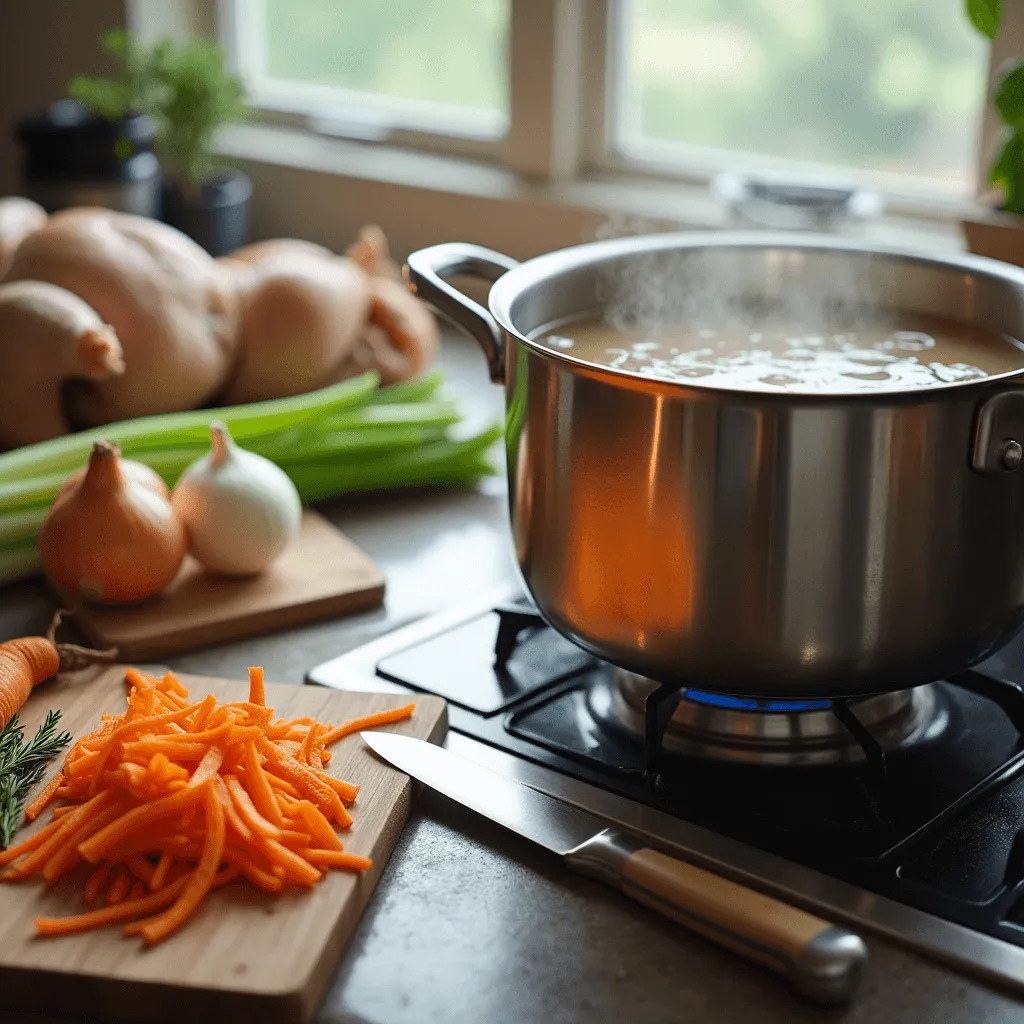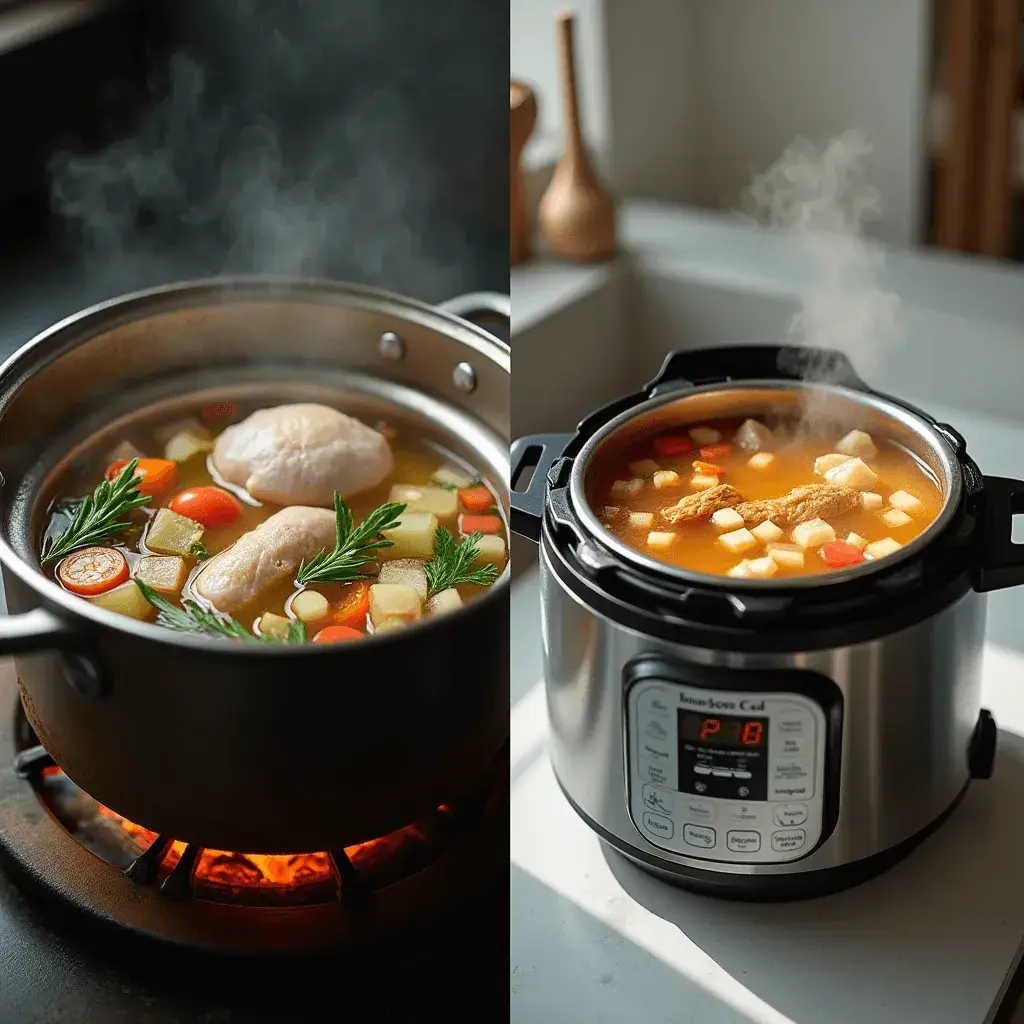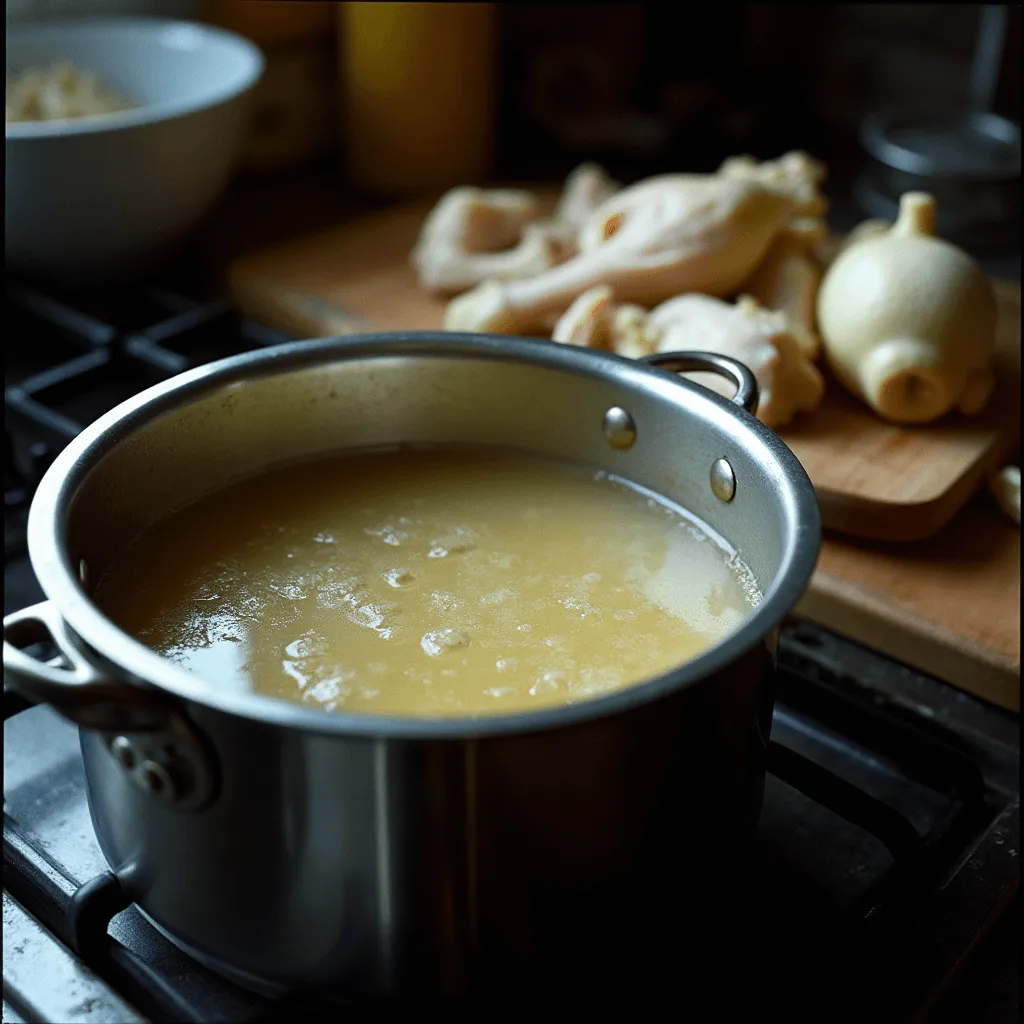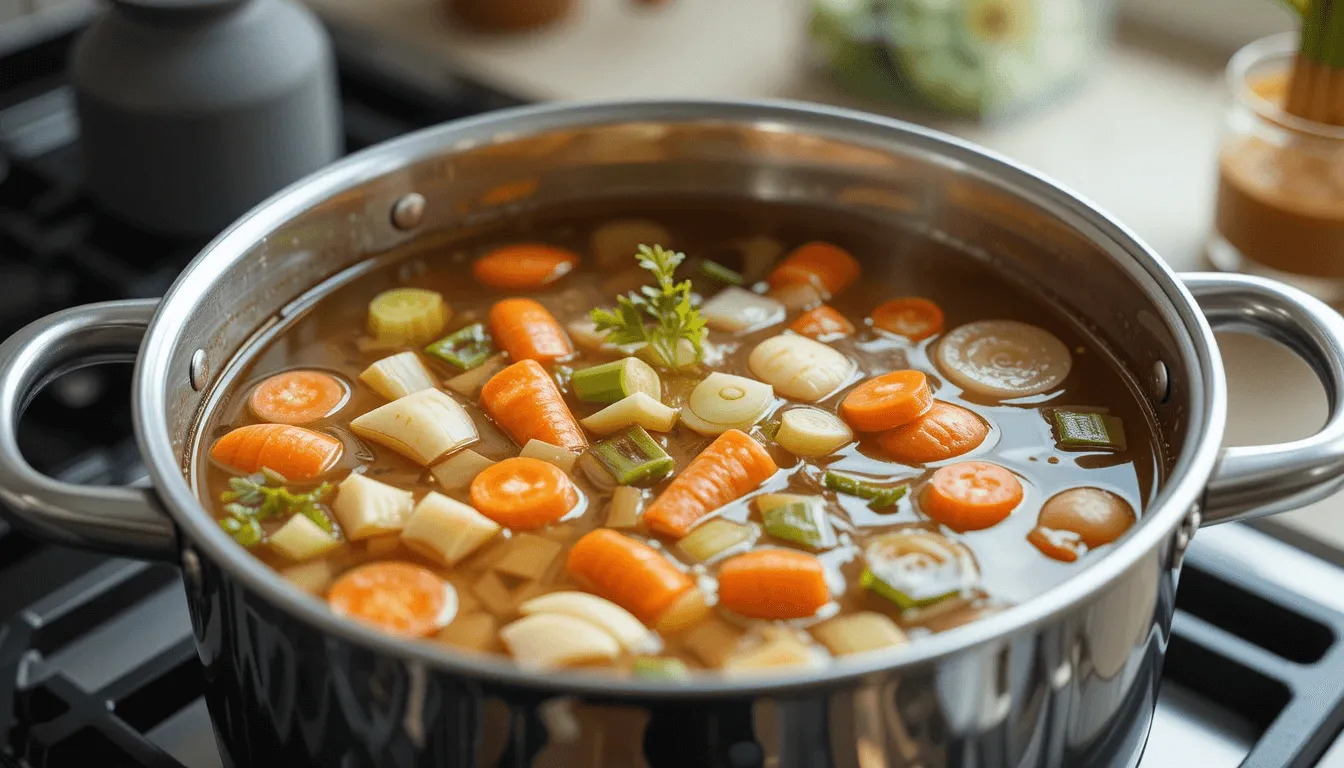Starting your journey to learn how to make chicken broth is exciting. You’ll discover how simple and rewarding it can be. This guide will help you, whether you’re a pro or just starting out. Making homemade stock is an art that’s worth the patience, and mastering how to make chicken broth is the first step.
You’ll learn everything from the basics to advanced techniques to make top-notch homemade stock. By the end, you’ll be confident in how to make chicken broth that’s both delicious and nutritious. It’s perfect for adding flavor and health to your favorite dishes.
Table of contents
Understanding the Basics of Chicken Broth
To make a tasty and healthy chicken broth, you need to know the chicken broth basics. It’s important to understand the difference between stock and broth. Also, making it at home has many benefits. Learning these basics helps you make better choices for your diet and create a broth that’s just right for you.
Making your own chicken broth has many perks. You can control how much sodium goes into it, which is great for those watching their salt intake. Plus, homemade broth usually tastes better and is more nutritious than store-bought versions.
Difference Between Stock and Broth
Stock and broth are often confused with each other, but they’re not the same. Stock is made with bones and is used as a base for other dishes. Broth, on the other hand, is made with meat and veggies and is often eaten on its own.
Benefits of Homemade Chicken Broth
Some key benefits of homemade chicken broth include:
- Higher nutritional value
- Lower sodium content
- Customizable flavor
- Cost-effective
Essential Nutritional Information
Knowing the nutritional facts of your homemade broth is key for a healthy diet. A typical serving of chicken broth has:
| Nutrient | Amount |
|---|---|
| Protein | 6-8 grams |
| Fat | 2-3 grams |
| Carbohydrates | 6-8 grams |
By understanding these chicken broth basics and the homemade benefits, you’re ready to make a delicious and nutritious broth that meets your needs.
Essential Equipment for Making Chicken Broth
To make delicious homemade chicken broth, you’ll need the right equipment for chicken broth. You’ll need a large pot, a strainer, and storage containers. The size of your pot depends on how much broth you want to make.
A strainer is key for removing solids from your broth. Storage containers keep your broth fresh longer. Good quality equipment for chicken broth makes the process easier and more efficient. Here are some important items to consider:
- A large stockpot with a heavy bottom for even heat distribution
- A fine-mesh strainer for removing solids from the broth
- Storage containers that are airtight and can be refrigerated or frozen
Having the right equipment for chicken broth greatly improves your broth’s quality. It’s worth investing in durable, high-quality items.

Choosing the Right Ingredients
When making homemade chicken broth, the ingredients you choose are key. You want chicken broth ingredients that taste great and are good for you. Use a whole chicken, wings, necks, and backs for the best flavor.
Carrots, celery, and onions are must-haves for adding flavor. They’re also full of vitamins and minerals. Don’t forget garlic and herbs for a unique taste.
Best Cuts of Chicken to Use
- Chicken wings
- Necks and backs
- Whole chicken
Recommended Vegetables and Aromatics
- Carrots
- Celery
- Onions
- Garlic

Choosing the right chicken broth ingredients and recommended vegetables makes a great broth. It’s perfect for soups, stews, and more. Pick fresh, high-quality ingredients for the best taste and nutrition.
How to Make Chicken Broth Step by Step
To start making chicken broth, you need to prepare your ingredients. Choose the right chicken cuts like wings, necks, and backs. Also, pick vegetables like carrots, celery, and onions.
After getting your ingredients, mix them in a large pot. The secret to great chicken broth is to simmer it slowly. This lets the flavors mix well and the collagen break down.
Here are the steps to follow for making chicken broth step by step:
- Combine chicken and vegetables in a large pot
- Add cold water to cover the ingredients
- Bring to a boil, then reduce heat to a simmer
- Simmer for 6-24 hours, depending on desired richness and flavor

By following these steps, you’ll make a delicious and healthy homemade chicken broth. Don’t forget to skim off any impurities that rise to the surface. Season with salt and pepper to taste.
Traditional vs. Quick-Cook Methods
There are two main ways to make chicken broth: traditional and quick-cook. Traditional methods simmer the broth on the stovetop or in a slow cooker for a long time. This makes the broth richer and more complex. Quick-cook methods, on the other hand, use a pressure cooker to cook the broth much faster.
The cooking time and method can change how your broth tastes. Knowing the good and bad of each method helps you pick the best way to make your chicken broth. Traditional methods give a deeper flavor, while quick-cook methods save time.

- Stovetop simmering technique: This traditional method allows for a high level of control over the cooking process and can result in a rich, flavorful broth.
- Pressure cooker method: This quick-cook method is ideal for those short on time, as it can reduce the cooking time by up to 70%.
- Slow cooker approach: This traditional method is perfect for hands-off cooking, as it allows you to simply set it and forget it.
Choosing between traditional and quick-cook methods depends on what you prefer and how much time you have. By knowing the pros and cons of each, you can decide and make a tasty, homemade chicken broth that fits your needs.
Common Mistakes to Avoid
When making homemade chicken broth, it’s key to know common mistakes. Using low-quality ingredients can make the broth taste bad and lack nutrients. Simmering time is also important. If you don’t simmer long enough, the flavors won’t mix well.
Another mistake is not straining the broth well. This can leave solids in and make it cloudy. To avoid these mistakes, use good ingredients, simmer right, and strain carefully. This way, you can make a tasty and healthy chicken broth.
Some other mistakes to dodge when making chicken broth include:
- Not using enough aromatics, like onions and carrots, which add flavor
- Not skimming the fat from the broth’s surface, which can make it greasy
- Not storing the broth right, which can spoil it or let in bacteria

By avoiding these mistakes, you can make a delicious and healthy broth. Always use top-notch ingredients, simmer right, and strain well. This ensures a clear and tasty broth for soups, stews, and more.
Straining and Clarifying Your Broth
After cooking your chicken broth, it’s time to strain and clarify it. This step is key to making your broth clear and appealing. You can use a fine-mesh sieve or cheesecloth to get rid of solids.
Straining and clarifying broth needs patience and detail. Start by using a fine-mesh sieve to catch large solids. Then, cheesecloth or a coffee filter can help remove smaller particles. You might need to do this a few times to get it just right.
To make your broth even clearer, try using egg whites or ice. This method is called rafting. It involves adding a bit of egg whites or ice and straining again. The egg whites or ice pull out any last impurities, leaving you with a clear broth. This way, you can make a delicious homemade chicken broth for soups and stews.
- Use a fine-mesh sieve to remove large solids
- Use cheesecloth or a coffee filter to strain the broth
- Repeat the straining process several times for clarity
- Use egg whites or ice to remove remaining impurities
Straining and clarifying your broth makes it rich in flavor and nutrients. It might take some time and effort, but it’s worth it. With practice, you can make delicious homemade chicken broth all year.
Storage Tips and Guidelines
After making homemade chicken broth, it’s key to store it right. This keeps it safe and tasty. Follow safe food handling to avoid contamination and spoilage.
To cool the broth quickly, place the pot in an ice bath or add cold water. Once it’s cooled, put it in airtight containers. Leave about an inch of space at the top to prevent bacteria growth.
Here are some important tips for storing chicken broth:
- Refrigerate the broth at 40°F (4°C) or below.
- Use shallow containers to cool the broth fast.
- Label and date the containers for easy tracking.
- Freeze the broth for longer storage. Frozen broth can last up to 3 months.
By following these tips, you can enjoy your homemade chicken broth longer. Always check for spoilage before using it. If it smells bad or has a slimy texture, throw it away.
Creative Ways to Use Chicken Broth
Chicken broth can make your meals special. It’s great for soups, stews, and sauces. It also adds flavor to grains, veggies, and proteins.
Here are some creative ways to use chicken broth:
- Making a delicious chicken noodle soup by simmering chicken broth with noodles and your favorite vegetables
- Using chicken broth as a substitute for water when cooking rice or quinoa for added flavor
- Adding chicken broth to your favorite stir-fry recipe for a boost of moisture and flavor
Soup Base Applications
Chicken broth is perfect for soups. Add your favorite veggies, proteins, and spices for a tasty meal.
Cooking with Broth
Cooking with chicken broth adds moisture and flavor. Use it for grains, veggies, and proteins, or as water in recipes.
Flavor Enhancement Ideas
Chicken broth enhances dish flavors. Use it for sauces or add it to recipes for extra taste.
Troubleshooting Your Chicken Broth
When you make homemade chicken broth, you might run into problems. Troubleshooting chicken broth needs patience and trying different things. You could find your broth too salty, too bland, or tastes off. To fix these issues, you can tweak the seasoning, add more ingredients, or make a new batch.
To solve common chicken broth problems, follow these steps:
- Check the seasoning: If it’s too salty, mix in some water. If it’s too bland, add more salt or herbs.
- Adjust the ingredients: If a certain ingredient is causing a bad taste, try leaving it out or using something else.
- Start over: If your broth can’t be fixed, start fresh. This way, you can try new ingredients or methods.
By following these steps and practicing troubleshooting chicken broth, you’ll get better at fixing problems. This will lead to a tastier homemade chicken broth. Always stay patient and open to trying new things until you succeed.
Health Benefits and Dietary Considerations
Chicken broth offers many health benefits when added to your meals. It’s packed with protein, collagen, and minerals. These make it a great choice for a healthy diet. It also helps with digestion, reduces inflammation, and boosts your immune system.
Chicken broth can fit into different diets too. If you’re watching your sodium or avoiding gluten, making your own broth is smart. This way, you can control what goes into it. Knowing the benefits and dietary needs helps you make better choices for your health.
Here are some tips for dietary restrictions:
- Low sodium options: use little salt or no salt at all
- Gluten-free options: skip ingredients like wheat or barley
By keeping these tips in mind, you can enjoy chicken broth’s health perks. And you can do it while keeping your diet balanced and healthy.
Conclusion: Mastering Your Homemade Chicken Broth
Making homemade chicken broth is a journey that requires patience and practice. But the end result is so rewarding. By following the steps in this guide, you’ll soon be making delicious and healthy broth for your kitchen.
The secret to great chicken broth is using top-notch ingredients, slow simmering, and proper straining. These steps are key to achieving a flavorful broth.
With patience and the right techniques, you’ll become a pro at making homemade chicken broth. It’s perfect for soups, sauces, or just enjoying on its own. Your homemade chicken broth will change the way you cook.
So, dive into the process, try new flavors, and enjoy the joy of making a nourishing staple. Your cooking will soar to new levels. Happy broth-making!
FAQ
What is the difference between stock and broth?
Stock and broth are often confused, but they’re different. Stock is made from bones and is a base for dishes. Broth, made with meat and veggies, is often eaten alone.
What are the benefits of making homemade chicken broth?
Making your own chicken broth is better than store-bought. It’s more nutritious and has less sodium. It’s full of protein, collagen, and minerals, helping with digestion and boosting your immune system.
What equipment do I need to make chicken broth?
To make great chicken broth, you’ll need a big pot, a strainer, and containers for storage. The pot size depends on how much broth you want. A strainer is key for removing solids. Containers keep your broth fresh longer.
What are the best cuts of chicken to use for broth?
For the best broth, use chicken with lots of collagen. This includes a whole chicken, wings, necks, and backs. These cuts make the broth richer and more flavorful.
What vegetables and aromatics should I add to my chicken broth?
Carrots, celery, and onions are great for broth. They add depth to the flavor. You can also add garlic, bay leaves, and peppercorns for extra taste.
How do I make chicken broth step-by-step?
Making chicken broth is simple. First, prepare your ingredients. Then, put them in a pot and simmer on low heat for 6 to 24 hours. This makes the broth rich and flavorful.
What are the different methods for making chicken broth?
There are many ways to make chicken broth. You can simmer it on the stovetop, use a pressure cooker, or a slow cooker. The stovetop method takes longer, but the quick methods are faster.
What common mistakes should I avoid when making chicken broth?
Avoid using low-quality ingredients and not simmering long enough. Also, make sure to strain it well. These mistakes can make your broth taste bad and lack nutrients.
How do I store and preserve my homemade chicken broth?
Cool your broth quickly and store it in airtight containers. Keep it in the fridge or freezer. Always follow safe food handling to keep your broth good and safe.
How can I use homemade chicken broth in my cooking?
Homemade chicken broth is very versatile. Use it as a base for soups, stews, and sauces. It’s also great for cooking grains, veggies, and proteins. It adds depth and richness to your dishes.
How can I troubleshoot and adjust my homemade chicken broth?
If your broth is too salty or bland, you can fix it. Adjust the seasoning or add more ingredients. Sometimes, you might need to start over. Be patient and keep trying until it’s just right.
What are the health benefits and dietary considerations of homemade chicken broth?
Homemade chicken broth is full of protein, collagen, and minerals. It’s good for digestion, reduces inflammation, and boosts your immune system. But, consider dietary needs like low sodium or gluten-free when making and eating it.

